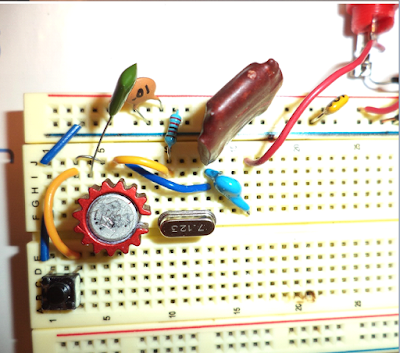Frank Jones and the FMLA -- Possible Victory?
IBEW Stickers: NASA, Johns Hopkins APL....
Cycle 25 Lookin Better Today: SFI 93 SN 47
Toobular! A Tube Transmitter
SR-160
Simple SSB rigs around the world!
KI7NSS's Pacific 40
The Mythbuster and the Struggle Against the Urban Legend
W2EWL's Cheap and Easy SSB
W4IMP's IMP. Articles in ER by Jim Musgrove K5BZH and Jim Hanlon W8KGI
The Spirit of Homebrew SSB. From Electric Radio K5BZH December 1991
Reduced Front End Gain on the DIGITIA
Back on 17! HP3SS sells HBR receiver to Joe Walsh
Maybe another Moxon?
NanoVNA -- Alan W2AEW helped solve mystery of why NanoVNA not providing accurate readout of circuit impedance. Over driving. Need attenuator.
TinySA -- Limited Resolution Bandwidth. But you can listen with it! See video on blog.
-- Google Feedburner to end e-mails from the blog :-(
-- Paul VK3HN -- TIA AGC? Farhan and Paul looking into options
-- Ciprian's Romanian Mighty Mite
-- Dino KL0S SolderSmoke GIF and graphical presentation on sideband inversion
-- Allison KB1GMX helped me on 24 volts to IRF 510 issue.
-- Dave K8WPE Wabi Sabi and Martha Stewart. And thanks for parts! 40673s!
-- Steve N8NM building a 17 meter rig with 22.1184 crystals in a SuperVXO and a 4 MHz filter.
-- Dean KK4DAS restoring an old Zenith. One hand behind your back OM.
-- Pete Eaton debating SSB or DSB for 17. Go DSB Pete!
-- Richard KN7FSZ a FB HBer. Asked about my solid-stating of Galaxy V VFO.
-- Walter KA4KXX on benefits of no-tune BP filters like Farhan's FB.
-- Jack 5B4APL on Time Crystals and Homebrewing in the 4th dimension. FB OM!
-- Moses K8TIY listens to the podcast with his young son Robert. Crank it in Robert!
-- Farhan and the SBitx on Hack-A-Day
-- Also Tom's receiver from junked satellite rig on Hack-A-Day
-- Todd K7TFC sent in beautiful message about the spirit of homebrewing. On the blog.
-- Grayson KJ7UM was on Ham Radio Workbench with George Zaf
-- AAron K5ATG running a uBitx with a homebrew tuner and antenna. Hope I can work him
-- Heard Mike WA3O last night on 40 DIGITIA. Water cooled amplifier



































